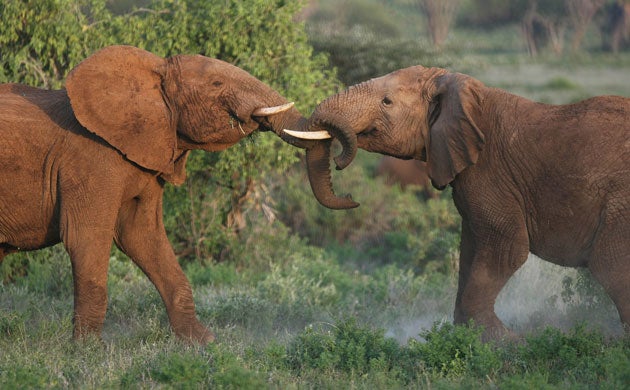An elephant just texted me - crop raid alert

The text message from the elephant flashed across Richard Lesowapir's screen: Kimani was heading for neighbouring farms.The huge bull elephant had a long history of raiding villagers' crops during the harvest, sometimes wiping out six months of income at a time. But this time, warned by the message sent by a mobile phone card inserted in Kimani's collar, ranger Lesowapir, an armed guard and a driver arrived in a jeep bristling with spotlights to frighten Kimani back into the Ol Pejeta conservancy.
Kenya is the first country to try elephant texting as a way to protect both a growing human population and the wild animals that now have less room to roam. Elephants are ranked as "near threatened" in the Red List, an International Union for Conservation of Nature index of vulnerable species.
The race to save Kimani began two years ago. The Kenya Wildlife Service had already reluctantly shot five elephants from the conservancy who refused to stop crop-raiding, and Kimani was the last of the regular raiders. The Save the Elephants group wanted to see if he could break the habit.
So they placed a mobile phone SIM card in Kimani's collar, then set up a virtual "geofence" using a global positioning system that mirrored the conservatory's boundaries. Whenever Kimani approaches the virtual fence, his collar texts rangers.
They have intercepted Kimani 15 times since the project began. Once almost a nightly raider, he last went near a farmer's field four months ago. It's a huge relief to the small farmers who rely on their crops for food and cash for school fees. Basila Mwasu, a 31-year-old mother of two, lives a stone's throw from the conservancy fence. She and her neighbours used to drum through the night on pots and pans in front of flaming bonfires to try to frighten the elephants away.
Once an elephant stuck its trunk through a window into a room where her baby daughter was sleeping and the family had stored some corn. She beat it back with a burning stick. Another time, an elephant killed a neighbour who was defending his crop.
Iain Douglas-Hamilton, founder of Save the Elephants, said the project was still in its infancy - so far only two geofences had been set up in Kenya - and it had its problems. Collar batteries wear out every few years. Sometimes communities think placing a collar on an elephant implies ownership and responsibility for the havoc it causes. And it's expensive work - Ol Pejeta has five full-time staff and a standby vehicle to respond to text messages.
But the experiment with Kimani has been a success, and the elephants can be tracked on Google Earth software, helping to map and conserve the corridors they use to move from one protected area to another. The tracking also helps prevent poaching, as rangers know where to deploy guarding resources.
Subscribe to Independent Premium to bookmark this article
Want to bookmark your favourite articles and stories to read or reference later? Start your Independent Premium subscription today.

Join our commenting forum
Join thought-provoking conversations, follow other Independent readers and see their replies